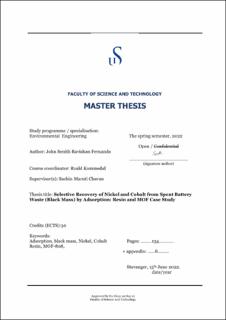| dc.description.abstract | In recent years, metal recycling and recovery from spent battery waste has become an area receiving much attention from the research community and environmentalists. With the rapid electrification of vehicles, battery manufacturing has increased in the presence of limited resources. Therefore, efficient and environmentally benign means of reusing the resources in spent battery waste is crucial for sustainability. Thus, this study was conducted with the objective of recovering critical metals: cobalt and nickel, using adsorption from the black mass.
Several characterization studies such as XRD, TGA, N2 sorption, SEM-EDS, ATR-IR and NMR were conducted for black mass and the adsorbents: Amberlite IRC-748 and Zr-MOF-808 to identify their properties. The batch adsorption experiments were conducted to determine the effects of pH, contact time, temperature, initial metal concentration, and liquid-solid ratio. MOF-808-EDTA showed the highest Ni2+ uptake from MOF-808 analogues considered with an adsorption capacity of 27.4 mg g-1 and 90 times selectivity for Ni2+ compared to Co2+ in simulated mixed solution. Amberlite IRC-748 showed better adsorption in as received sodium form compared to the treated form and over 99 % removal for Ni2+ and Co2+ in simulated black mass metal solution. Moreover, Amberlite IRC-748 exhibited consistent adsorption capacities for the 3 adsorption cycles considered. | |
